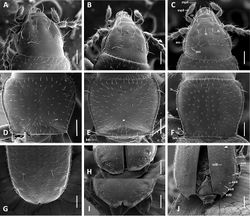Anillinus acutipennis
| Notice: | This page is derived from the original publication listed below, whose author(s) should always be credited. Further contributors may edit and improve the content of this page and, consequently, need to be credited as well (see page history). Any assessment of factual correctness requires a careful review of the original article as well as of subsequent contributions.
If you are uncertain whether your planned contribution is correct or not, we suggest that you use the associated discussion page instead of editing the page directly. This page should be cited as follows (rationale):
Citation formats to copy and paste
BibTeX: @article{Sokolov2014ZooKeys417, RIS/ Endnote: TY - JOUR Wikipedia/ Citizendium: <ref name="Sokolov2014ZooKeys417">{{Citation See also the citation download page at the journal. |
Genus: Anillinus
Name
Anillinus acutipennis Sokolov & Reddell sp. n. – Wikispecies link – ZooBank link – Pensoft Profile
Type material
HOLOTYPE, a female, deposited in CAS, point-mounted, dissected, labeled: \ TX: Bell Co., Talking Crows Cave, Fort Hood, 4.V.2006, J. Fant, M. Reyes \ Texas Memorial Museum Invertebrate Zool Coll #45.781 \ Holotype Anillinus acutipennis Sokolov & Reddell 2014 [red label] \. CAS Type No. 18870 \. PARATYPES: 2 females, both dissected; one, in CNC, labeled: \ TX: Bell Co., Hidden Pit Cave, Fort Hood, 27.X.2007, J. Reddell, M. Reyes \ Texas Memorial Museum Invertebrate Zool Coll #60.107 \; one, in TMM, labeled: \ TX: Hays Co., Wiseman Sink, 10mi, 2.IV.1995, A. G. Grubbs, C. Jordan \ Texas Memorial Museum Invertebrate Zool Coll #27.148 \. Both paratypes also labeled: \ Paratype Anillinus acutipennis Sokolov & Reddell 2014 [yellow label] \.
Type locality
U.S.A., Texas, Bell County, Fort Hood area.
Etymology
The specific epithet is a Latinized adjective in the masculine form and is derived from the Latin adjective acutus meaning "acute, sharpened" and the Latin noun penna meaning “feather, wing”. The epithet refers to the spinose apex of elytron in members of the new species.
Recognition
Adults of this new species are distinguished easily from those of other Texan species of the genus by the following combination of external characters: markedly elongated habitus, distinctly elongate pronotum with shallow basolateral sinuation, and incised elytral apex with a distinct spine.
Description
Medium-sized for genus (SBL range 1.62–1.84 mm, mean 1.74±0.116 mm, n=3).
Habitus. Body form (Fig. 5E) subdepressed, subparallel, markedly elongate (WE/SBL 0.33±0.009), head large for genus compared to pronotum (WH/WPm 0.80±0.006), pronotum wide in comparison to elytra (WPm/WE 0.88±0.013).
Color. Body rufotestaceous, appendages testaceous.
Microsculpture. Distinct over all dorsal surfaces of head, pronotum and elytra, with slightly transverse polygonal meshes of more or less scaly appearance on elytra.
Head. Labium (Fig. 3B). Mental tooth present; mentum and submentum separated by suture. Glossal sclerite with distinct paraglossae laterally and with two setae apically.
Prothorax. Pronotum (Fig. 2F) relatively long (LP/LE 0.42±0.016) and markedly elongated (WPm/LP 1.23±0.080), with lateral margins shallowly sinuate and moderately constricted posteriorly (WPm/WPp 1.28±0.020). Anterior angles indistinct, posterior angles nearly rectangular (90–100°). Width between anterior and posterior angles of approximately equal length (WPa/WPp 1.02±0.024). Basal margin straight.
Elytra (Fig. 2J). Widely depressed along suture, comparatively short (LE/SBL 0.57±0.004) and narrow for genus (WE/LE 0.59±0.020), with traces of 4-5 striae. Humeri distinct, rounded, in outline forming obtuse angle with longitudinal axis of body. Lateral margins subparallel, slightly divergent at basal fourth, evenly rounded to apex in apical fourth, without subapical sinuation. Vestiture of elytra short (less than one-third length of discal setae). Apex of elytron deeply emarginate, the notch with a distinct spine laterally.
Male unknown.
Female genitalia. Spermatheca with distal part of cornu only slightly dilated, gradually tapered to proximal part. Nodulus short, ramus undifferentiated (Fig. 7G).
Geographical distribution
This species has been found only in two remote areas of Bell (Lampasas Cut Plain) and Hays (Balcones Fault Zone) Counties, Texas (Fig. 8, white stars).
Way of life
This species has been found only in caves. The specimens from caves in Bell County were taken in darkness on the underside of rocks shallowly embedded in soil.
Relationships
In general habitus and in the modified apex of the elytra, members of this new species closely resemble Anillinus forthoodensis adults, described below; however, they are more similar to members of Anillinus comalensis, also described below, in the shape of the spermatheca. In the absence of males, the relationships of this species to the other Texan anillines is unclear. The presence of a spine on the lateral margin of the apex of the elytron is unique to this species among the known Anillinus species of Texas.
Original Description
- Sokolov, I; Reddell, J; Kavanaugh, D; 2014: Life beneath the surface of the central Texan Balcones Escarpment: genus Anillinus Casey, 1918 (Coleoptera, Carabidae, Bembidiini): new species, a key to the Texas species, and notes about their way of life and evolution ZooKeys, 417: 71-101. doi
Images
|
Other References
- ↑ Sokolov I, Carlton C, Cornell J (2004) Review of Anillinus, with descriptions of 17 new species and a key to soil and litter species (Coleoptera: Carabidae: Trechinae: Bembidiini). The Coleopterists Bulletin 58: 185–233. doi: 10.1649/611




![Figure 8. Locality records for Anillinus species: Anillinus acutipennis – white stars; Anillinus affabilis – black triangle; Anillinus comalensis – white diamond; Anillinus depressus – black diamond; Anillinus forthoodensis – white quadrangle; Anillinus lescheni – black circle Anillinus sinuatus– black quadrangle; Anillinus wisemanensis– white triangles; Anillinus spp. – white circles (1 – Bell and Coryell Counties; 2 – Williamson County; 3 – Bexar County). Violet color – range of the western Anillinus species in Arkansas and Oklahoma (Sokolov et al. 2004[1]). Light blue color – recharge zone of the Edwards Aquifer, dark blue color – the Balcones Escarpment, topographic expression of the Balcones Fault Zone (Woodruff and Abbot 1986). Contour of the Cross Timbers ecological region (highlighted) were taken from Wikipedia: http://en.wikipedia.org/wiki/Cross_Timbers. Elevation scale bar is given in meters.](https://species-id.net/o/thumb.php?f=Zookeys-417-071-g008.jpg&width=250)